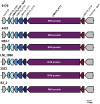Genomes of sequence type 121 Listeria monocytogenes strains harbor highly conserved plasmids and prophages
- PMID: 25972859
- PMCID: PMC4412001
- DOI: 10.3389/fmicb.2015.00380
Genomes of sequence type 121 Listeria monocytogenes strains harbor highly conserved plasmids and prophages
Abstract
The food-borne pathogen Listeria (L.) monocytogenes is often found in food production environments. Thus, controlling the occurrence of L. monocytogenes in food production is a great challenge for food safety. Among a great diversity of L. monocytogenes strains from food production, particularly strains belonging to sequence type (ST)121 are prevalent. The molecular reasons for the abundance of ST121 strains are however currently unknown. We therefore determined the genome sequences of three L. monocytogenes ST121 strains: 6179 and 4423, which persisted for up to 8 years in food production plants in Ireland and Austria, and of the strain 3253 and compared them with available L. monocytogenes ST121 genomes. Our results show that the ST121 genomes are highly similar to each other and show a tremendously high degree of conservation among some of their prophages and particularly among their plasmids. This remarkably high level of conservation among prophages and plasmids suggests that strong selective pressure is acting on them. We thus hypothesize that plasmids and prophages are providing important adaptations for survival in food production environments. In addition, the ST121 genomes share common adaptations which might be related to their persistence in food production environments such as the presence of Tn6188, a transposon responsible for increased tolerance against quaternary ammonium compounds, a yet undescribed insertion harboring recombination hotspot (RHS) repeat proteins, which are most likely involved in competition against other bacteria, and presence of homologs of the L. innocua genes lin0464 and lin0465.
Keywords: Listeria monocytogenes; genome; persistence; plasmid; prophage; sequence type 121.
Figures



Similar articles
-
Comparative genomics of human and non-human Listeria monocytogenes sequence type 121 strains.PLoS One. 2017 May 4;12(5):e0176857. doi: 10.1371/journal.pone.0176857. eCollection 2017. PLoS One. 2017. PMID: 28472116 Free PMC article.
-
Stress Survival Islet 2, Predominantly Present in Listeria monocytogenes Strains of Sequence Type 121, Is Involved in the Alkaline and Oxidative Stress Responses.Appl Environ Microbiol. 2017 Aug 1;83(16):e00827-17. doi: 10.1128/AEM.00827-17. Print 2017 Aug 15. Appl Environ Microbiol. 2017. PMID: 28625982 Free PMC article.
-
Population structure and gene flux of Listeria monocytogenes ST121 reveal prophages as a candidate driver of adaptation and persistence in food production environments.Microb Genom. 2025 Apr;11(4):001397. doi: 10.1099/mgen.0.001397. Microb Genom. 2025. PMID: 40243587 Free PMC article.
-
Listeria monocytogenes lineages: Genomics, evolution, ecology, and phenotypic characteristics.Int J Med Microbiol. 2011 Feb;301(2):79-96. doi: 10.1016/j.ijmm.2010.05.002. Epub 2010 Aug 13. Int J Med Microbiol. 2011. PMID: 20708964 Review.
-
Comparative and functional genomics of Listeria spp.J Biotechnol. 2006 Oct 20;126(1):37-51. doi: 10.1016/j.jbiotec.2006.03.047. Epub 2006 Jun 6. J Biotechnol. 2006. PMID: 16757050 Review.
Cited by
-
Virulence Potential and Antimicrobial Resistance of Listeria monocytogenes Isolates Obtained from Beef and Beef-Based Products Deciphered Using Whole-Genome Sequencing.Microorganisms. 2024 Jun 8;12(6):1166. doi: 10.3390/microorganisms12061166. Microorganisms. 2024. PMID: 38930548 Free PMC article.
-
Surveillance and genetic characterization of Listeria monocytogenes in the food chain in Montenegro during the period 2014-2022.Front Microbiol. 2024 Aug 1;15:1418333. doi: 10.3389/fmicb.2024.1418333. eCollection 2024. Front Microbiol. 2024. PMID: 39149205 Free PMC article.
-
Predominance of Distinct Listeria Innocua and Listeria Monocytogenes in Recurrent Contamination Events at Dairy Processing Facilities.Microorganisms. 2020 Feb 10;8(2):234. doi: 10.3390/microorganisms8020234. Microorganisms. 2020. PMID: 32050536 Free PMC article.
-
Birmingham-group IncP-1α plasmids revisited: RP4, RP1 and RK2 are identical and their remnants can be detected in environmental isolates.Microb Genom. 2025 Mar;11(3):001381. doi: 10.1099/mgen.0.001381. Microb Genom. 2025. PMID: 40152918 Free PMC article.
-
Persistence of Listeria monocytogenes ST5 in Ready-to-Eat Food Processing Environment.Foods. 2022 Aug 24;11(17):2561. doi: 10.3390/foods11172561. Foods. 2022. PMID: 36076746 Free PMC article.
References
LinkOut - more resources
Full Text Sources
Other Literature Sources

